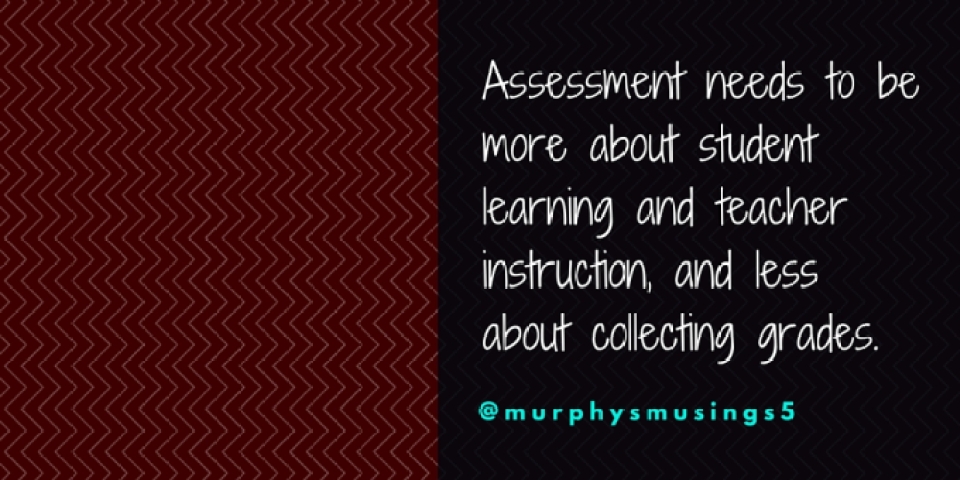Nitty Gritty of Assessment
 As with many teachers, my only experience with assessments came from my experience taking them as a student. Upon reflection, I can say with confidence, that my personal assessment experience is not rooted in best practice. However, with little else to go on, why not stick with the most comfortable and readily available resources?
As with many teachers, my only experience with assessments came from my experience taking them as a student. Upon reflection, I can say with confidence, that my personal assessment experience is not rooted in best practice. However, with little else to go on, why not stick with the most comfortable and readily available resources?
Over the last two years, I was forced to think critically about my beliefs related to assessment. I assisted with the revision of elementary common assessments and soon after began working in a middle school with a principal passionate about reforming assessment and grading practices. While calling assessment one of my passions would be a stretch, it is hard to deny its ever present influence on everything we do in our classrooms. So, for that reason, I present my Nitty Gritty of Assessment (see previous Nitty Gritty posts here).
Assess what you intend to assess.
Is your assessment assessing what you intend? “Of course,” is the gut reaction to this question. However, my experience as a teacher and administrator indicate otherwise. Regardless of the sticker on the front of the book, canned assessments (from textbooks, Teachers Pay Teachers, etc) are terrible at assessing specific skills or topics. They are often overbroad and thus provide a foggy picture of student understanding.
What to do?
- Identify clear objectives. Perhaps your district curriculum has already done this for you. If not, you may need to unpack your standards.Put the objective(s) right on the assessment.
- When possible, format the assessment by objective to allow for clear feedback.
- Only include assessment questions directly related to your objectives. Cut the extra stuff. This saves you time grading and emphasizes to students the content that is most important.
- Have another teacher (bonus if they teach a different content area) identify the http://edexcellence.net/articles/if-national-test-scores-are-down-blame-the-recession purpose. If they do not know, then a revision is necessary.
Make it uncheatable.
High quality assessments are uncheatable. Meaning, they require a level of synthesis that goes far beyond copying letters off the paper next to them or hearing, “The answer to number 12 is C,” in the hallway.
What to do?
- Generate prompts that require students to create new meaning.
- Allow students to use their resources during the assessment. If having a text or notes in front of them during the assessment gives away the answer, you are asking the wrong types of questions.
- If multiple choice is necessary, synthesis can still occur. Rigor can be embedded into multiple choice questions by writing questions that require students to make connections or inferences.
Low Rigor: “What color shirt was the main character wearing at the beginning of the book?”
Higher Rigor: “Why did the author choose to have the main character wear a red shirt at the beginning of the book?”
The grade reflects learning.
Ideally, we would not need to apply grades to student work, at all. We could simply report progress toward an objective on a continuum or through thoughtful feedback. However, since most of us operate in a system where grades are still a requirement, a student’s assessment grade should paint a clear picture of that child’s understanding of the given topic. Tangential information has a way of creeping into some grading practices and this clouds the information transmitted by the grade.
What to do? (…or what not to do, in this case)
- No extra credit.
- Do not take off points for late work.
- Do not allow conventions and spelling to consume the grade. If a student spelled Byzantine incorrectly, but was able to explain its survival after the western half of the Roman Empire fell, the spelling clearly did not impact their understanding of the content.
The results instigate action.
“Assessment should drive instruction.” This phrase is repeated so often it has become a bit of an educational cliche. Unfortunately, I am not sure the practice is implemented as often as the phrase is used. If you take a child’s temperature and they have a fever, you do not move on with your day. An intervention, probably acetaminophen, is applied as a remedy. The same should be true for assessment.
What to do?
- Provide feedback. Thoughts on feedback could consume an entire post, or possibly a book. The important take away: feedback is essential. It should be clear and students should be able to understand exactly what they knew and could do, and exactly where they still need some work.
- After an assessment, review the results.
What do the results say about my instruction?
What additional information may students need before moving on?
How can I differentiated my next steps to meet the needs of all students?
Did many students make the same mistake? Review the question or prompt to check for clarity.
In the end, assessment needs to be more about student learning and teacher instruction, and less about collecting grades. How do you harness the power of assessment to create a culture of learning in your classroom or school? What resources do you use to ensure the quality of your assessments?


